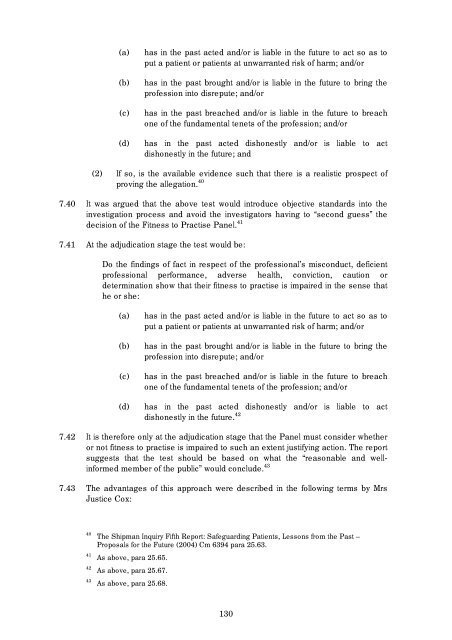Regulation of Health and Social Care Professionals Consultation
Regulation of Health and Social Care Professionals Consultation
Regulation of Health and Social Care Professionals Consultation
You also want an ePaper? Increase the reach of your titles
YUMPU automatically turns print PDFs into web optimized ePapers that Google loves.
(a) has in the past acted <strong>and</strong>/or is liable in the future to act so as to<br />
put a patient or patients at unwarranted risk <strong>of</strong> harm; <strong>and</strong>/or<br />
(b) has in the past brought <strong>and</strong>/or is liable in the future to bring the<br />
pr<strong>of</strong>ession into disrepute; <strong>and</strong>/or<br />
(c) has in the past breached <strong>and</strong>/or is liable in the future to breach<br />
one <strong>of</strong> the fundamental tenets <strong>of</strong> the pr<strong>of</strong>ession; <strong>and</strong>/or<br />
(d) has in the past acted dishonestly <strong>and</strong>/or is liable to act<br />
dishonestly in the future; <strong>and</strong><br />
(2) If so, is the available evidence such that there is a realistic prospect <strong>of</strong><br />
proving the allegation. 40<br />
7.40 It was argued that the above test would introduce objective st<strong>and</strong>ards into the<br />
investigation process <strong>and</strong> avoid the investigators having to “second guess” the<br />
decision <strong>of</strong> the Fitness to Practise Panel. 41<br />
7.41 At the adjudication stage the test would be:<br />
Do the findings <strong>of</strong> fact in respect <strong>of</strong> the pr<strong>of</strong>essional’s misconduct, deficient<br />
pr<strong>of</strong>essional performance, adverse health, conviction, caution or<br />
determination show that their fitness to practise is impaired in the sense that<br />
he or she:<br />
(a) has in the past acted <strong>and</strong>/or is liable in the future to act so as to<br />
put a patient or patients at unwarranted risk <strong>of</strong> harm; <strong>and</strong>/or<br />
(b) has in the past brought <strong>and</strong>/or is liable in the future to bring the<br />
pr<strong>of</strong>ession into disrepute; <strong>and</strong>/or<br />
(c) has in the past breached <strong>and</strong>/or is liable in the future to breach<br />
one <strong>of</strong> the fundamental tenets <strong>of</strong> the pr<strong>of</strong>ession; <strong>and</strong>/or<br />
(d) has in the past acted dishonestly <strong>and</strong>/or is liable to act<br />
dishonestly in the future. 42<br />
7.42 It is therefore only at the adjudication stage that the Panel must consider whether<br />
or not fitness to practise is impaired to such an extent justifying action. The report<br />
suggests that the test should be based on what the “reasonable <strong>and</strong> wellinformed<br />
member <strong>of</strong> the public” would conclude. 43<br />
7.43 The advantages <strong>of</strong> this approach were described in the following terms by Mrs<br />
Justice Cox:<br />
40 The Shipman Inquiry Fifth Report: Safeguarding Patients, Lessons from the Past –<br />
Proposals for the Future (2004) Cm 6394 para 25.63.<br />
41 As above, para 25.65.<br />
42 As above, para 25.67.<br />
43 As above, para 25.68.<br />
130
















